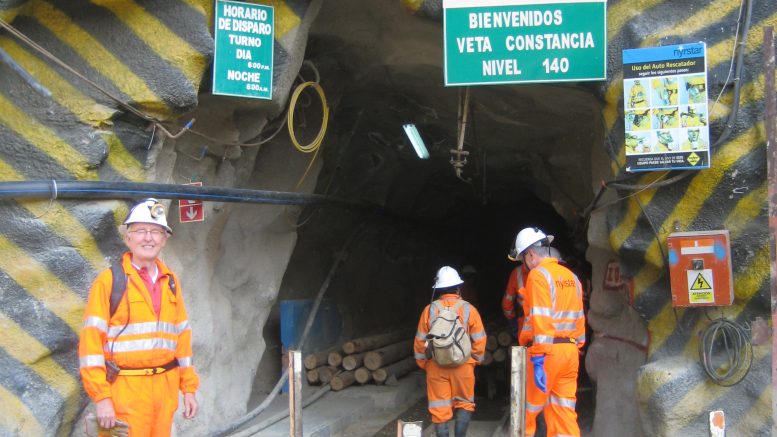Junior silver miner Great Panther Silver (TSX: GPR; NYSE: GPL) has acquired Belgian smelting giant Nyrstar’s idled Coricancha gold-silver-lead-zinc-copper mine and mill complex, 90 km east of Lima, Peru.
The 600-tonnes-per-day underground mine, which has been under care and maintenance since 2013, could boost Great Panther’s metal production by 3 million oz. silver eq., or 75%, once back in operation.
Great Panther president and CEO Robert Archer tells The Northern Miner during a phone interview that the acquisition is part of his company’s plan to expand further into Latin America. Archer says the best way to grow the company is through acquisition, as its two operations in Mexico — the Guanajuato silver-gold mine complex, which includes the San Ignacio mine, and the Topia silver-lead-zinc mine — are “at full capacity.”
“I’ve been trying to get something going in Peru for seven years,” he says. “We’ve negotiated on other assets in the past but they’ve always fallen through.
“Coricancha has everything we were looking for. It’s fully permitted, has a very sizeable resource with high grades, and can be brought into production within 18 months. Once we get ourselves established at Coricancha and build a reputation for ourselves, hopefully that will expose us to new opportunities in the country.”

Great Panther Silver’s Coricancha polymetallic mine, 90 km east of Lima, Peru. The junior miner purchased the idled underground mine from Nyrstar in June. Credit: Great Panther Silver.
Great Panther purchased Coricancha for US$100,000 in cash, and 15% of the annual free cash flow generated from the operation for five years, up to a maximum US$10 million.
Archer says the annual payments to Nyrstar will begin after Great Panther recoups any investment dollars used to restart the operation.
“These kinds of deals are common in other industries, but not so much in mining. It’s a risk-sharing deal. If the project generates free cash flow, then we pay. If it’s not successful for any reason, then we’ve only spent money in the ground — we haven’t lined their pockets while we get stuck with the project,” he says.
As part of the agreement, Nyrstar will also cover up to US$20 million in reclamation costs, and up to US$4 million in any fines, associated with mine’s historical dry tailings facility.
Nyrstar’s cash commitment should be “more than enough,” to cover reclamation costs, Archer adds.
Coricancha comes with a processing plant and bio-leaching facility that extracts gold from refractory ore. Great Panther estimates it could cost US$25 million to restart the operation.
“Metal prices dropped and Nyrstar wasn’t having a lot of success for a variety of reasons. It wasn’t a mining company per se; it was more focused on smelting,” he says. “The resource grade, just in gold, is running 5 grams per tonne, yet they were processing just over 3 grams at the plant, so they experienced some pretty substantial dilution. It’s an underground narrow vein, not that different from our Mexican operations, so we’re quite comfortable with maintaining good grade control.”
With the acquisition already closed, Great Panther is launching into a prefeasibility study to update the mine’s historical resource and review optimization plans to lower costs. Archer says the study should be complete in the first quarter 2018, after which Great Panther will be in a position to make a production decision.
Coricancha’s historical resource is 890,000 measured and indicated tonnes of 5.04 grams gold per tonne, 175 grams silver per tonne, 1.97% lead, 3.11% zinc and 0.42% copper. Inferred resources add 4.9 million tonnes of 4.91 grams gold, 225 grams silver, 1.57% lead, 2.98% zinc and 0.48% copper.
The estimate was based on commodity prices of US$22 per oz. silver, US$1,300 per oz. gold, US$6,300 per tonne copper and US$2,250 per tonnes lead and zinc.
“We’ll be making our conversion to current spot prices, which is lower than in the past, so the resource we’ll publish will likely be smaller,” he says. “But the idea is to start from there and expand upon that. Our drilling will focus on the high grade zones. The trick with narrow vein deposits is to make sure you have a sufficient number of operating stopes to provide high grade tonnes to the mining plan.”
In the second quarter, Great Panther produced 1.1 million oz. silver eq. from 98,576 tonnes at its Guanajuato and Topia operations. The company expects to produce up to 4.1 million oz. silver eq. in 2017 at all-in sustaining costs between US$14 and US$16 per payable oz. silver.
Archer, who has served as the company’s president and CEO for almost 15 years and co-founded the company, is planning to resign from those roles.
“My decision to step down is largely driven by our growth strategy,” he says. “Rather than continue on for the next few years, it makes more sense to bring someone else in now, so they can have more ownership in the strategy and perhaps identify what opportunities the company will pursue. I’ll remain on the board and work through the transition for as long as it takes.”


Be the first to comment on "Great Panther buys Nyrstar’s Coricancha"